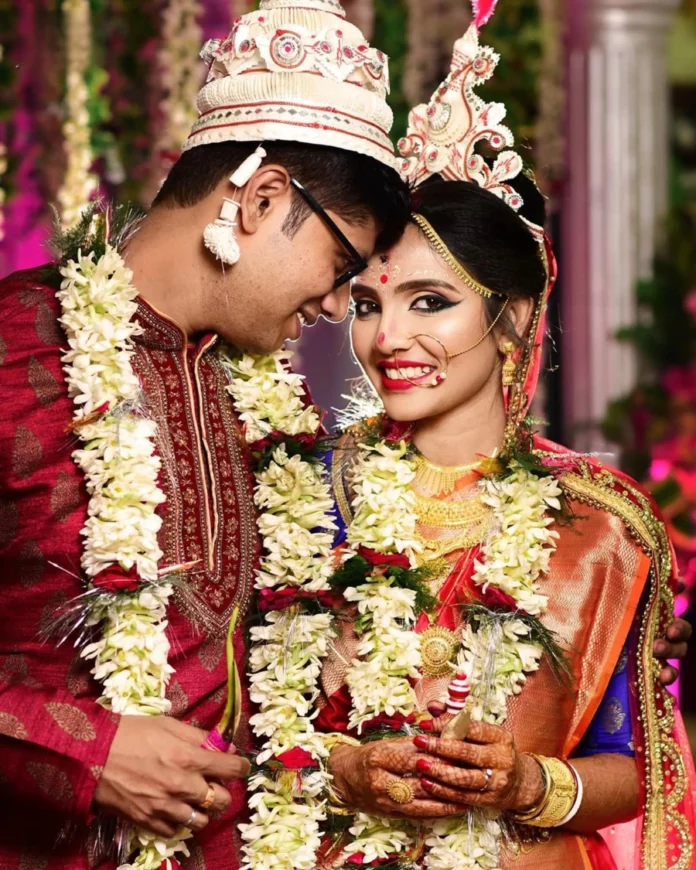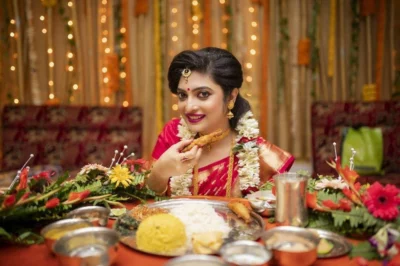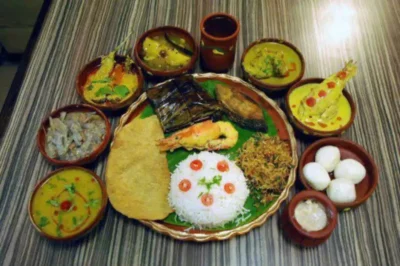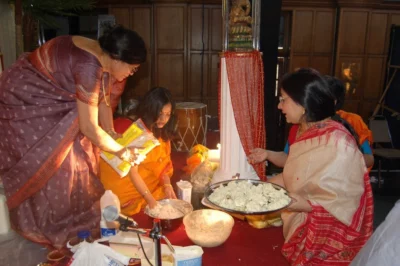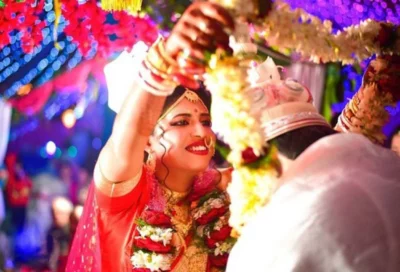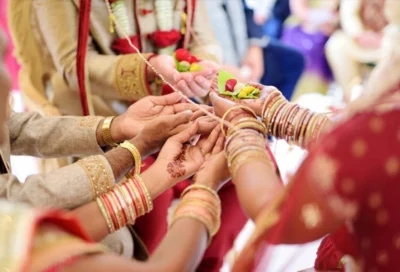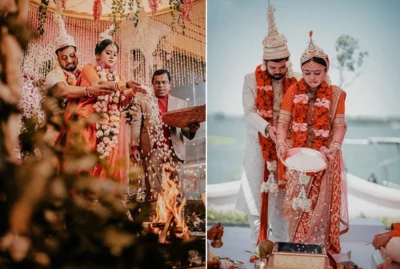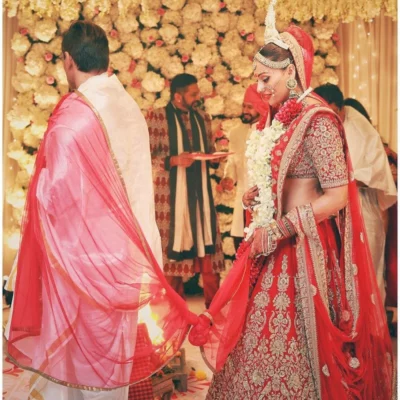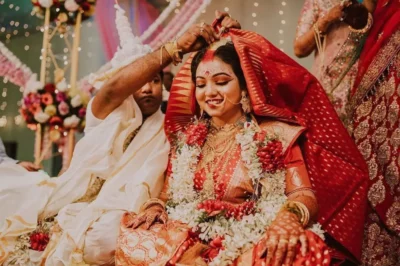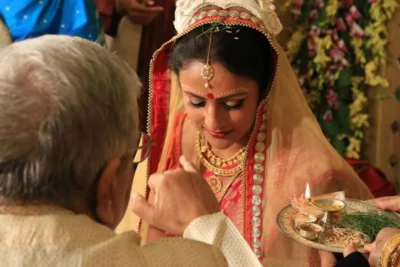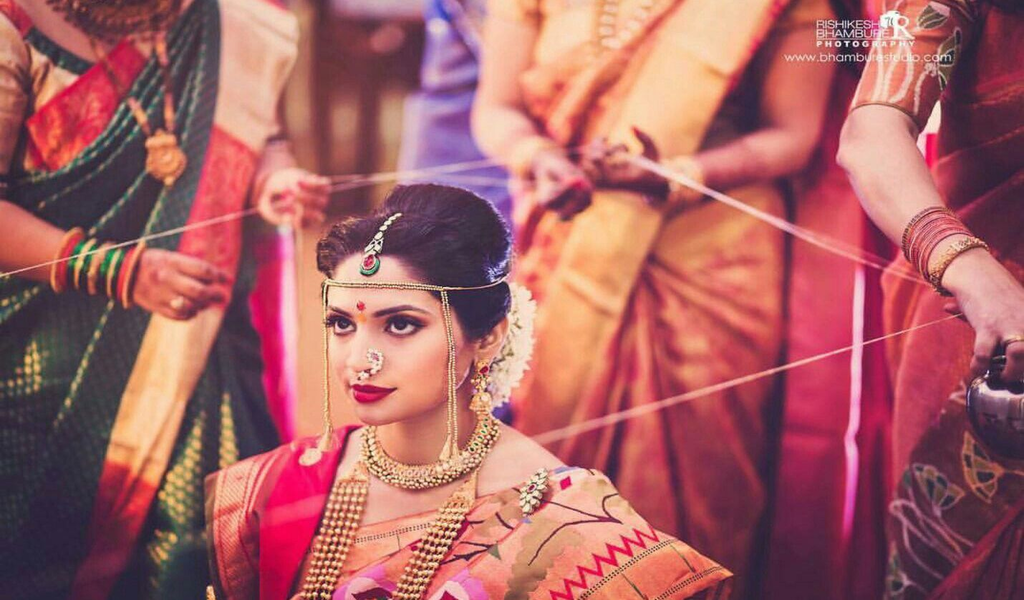Marriage rituals in Bengal are not only a celebration of love and commitment but also a reflection of the region’s rich cultural heritage and traditions. These rituals unite families and communities, emphasising the importance of unity, blessings, and divine intervention in ensuring a successful and fulfilling marital journey for the bride and groom.
Bengali weddings are known for their rich cultural traditions and elaborate rituals. While priestly rituals play a significant role, there are also non-priestly rituals that hold immense importance. These rituals, performed by married women, are believed to bring good fortune and happiness to the couple. The non-priestly marriage rituals of Bengal hold deep cultural significance and reflect the region’s rich traditions.
Pre-Wedding Rituals
Bengali weddings are not confined to a single day; they involve preparations and rituals that span several days. Before the actual wedding day, various rituals take place, including:
Āibuḍobhāta (Bachelor’s Meal)
The bachelor’s meal, known as āibuḍobhāta, is offered to the bride and groom a day before the wedding. This ritual is attended only by female family members.
Preparing Perched Rice and Anandanāḍu
In some families of West Bengal, the preparation of perched rice and sesame ladoos, known as ānandanāḍu, takes place a day before the wedding. Married women ceremoniously prepare these items, which hold cultural significance.
The Maṅgalghar
The non-priestly rituals in the Śunḍi family of West Bengal are performed in a designated room called the maṅgalghar. It is here that the preparation of perched rice takes place, surrounded by sacred items.
Wedding Day Rituals
On the wedding day, various rituals are performed, signifying the beginning of a new chapter in the couple’s lives. These rituals include:
Dodhimaṅgal
Many Bengali weddings rituals are conducted by married women, colloquially called eyo. Early in the morning, an eyo from the bride’s family places a holy pitcher filled with water and mango leaves in the maṅgalghar.
Sohāg Thokāno and Sohāg Māpā
In some families, a ritual known as sohāg thokāno occurs, where a couple with a happy marital life collects soil from the house’s four corners. This soil is placed in the bride’s sari pallu. Another ritual called sohāg māpā occurs, marking rice pudding with the groom’s ring.
Monāmuni Grinding
The bride and groom perform the monāmuni grinding ritual. Monāmuni, two tiny seeds with filaments, are ground with a cowry shell to create a paste. This paste is later used during the bathing ritual.
Marriage Rituals
The main marriage rituals occur once the bridegroom arrives at the bride’s house and the initial rituals are completed. These rituals vary in their specific practices and traditions across different regions and communities. Let’s delve into the various marriage rituals:
Circumambulation and Garlanding
One of the fundamental rituals in a Bengali weddings is the circumambulation and garlanding ceremony. The bride, seated on an inverted stool or a designated seat, is encircled by the groom. The groom, accompanied by male family members, circles the bride seven times. During this ritual, the bride and groom exchange garlands three times, symbolising their acceptance and commitment to each other.
Sampradāna
After the circumambulation and garlanding ceremony, the main priestly ritual, Sampradāna, occurs. The priest of the bride’s family officiates this ritual, signifying the formal giving away of the bride to the groom. The priest chants Vedic mantras and performs sacred rites, invoking divine blessings for the couple’s lifelong journey together.
Kuśanḍikā
In certain regions and communities, the Kuśanḍikā ritual is performed. This ritual involves the bride and groom offering rice grains into a sacred fire while the priest recites Vedic mantras. Offering rice into the fire symbolises the couple’s commitment to supporting each other and fulfilling their responsibilities as husband and wife.
Saptapadī
Saptapadī, meaning “seven steps,” is a significant ritual that symbolises the seven sacred vows taken by the bride and groom. The couple walks together, taking seven steps while making promises to each other for a harmonious and fulfilling marital life. Each step represents a specific commitment, such as nurturing love, respecting each other’s families, and supporting each other through joy and sorrow.
Lājhoma
Lājhoma is another vital ritual that follows the Saptapadī. It involves the bride placing her right foot on a stone or grinding stone while the groom holds her right foot. The priest recites mantras, and the groom helps the bride balance her foot on the stone, signifying their shared strength and stability in facing the challenges of married life.
Sindur Daan and Mangal Sutra
The ritual of Sindur Daan holds immense significance in Bengali weddings. The groom applies vermilion (sindoor) on the parting of the bride’s hair, signifying her transition from a maiden to a married woman. This act represents the groom’s acceptance of his responsibilities as a husband and protector of his wife.
Ashirvād
After completing the main marriage rituals, the couple seeks blessings (ashirvād) from their elders and respected family members. The elders shower the couple with wishes, wisdom, and blessings for a blissful and prosperous married life.
Wedding Feast and Celebrations
Following the marriage rituals, a grand wedding feast is hosted, where family, relatives, and friends come together to celebrate the couple’s union. Elaborate meals and traditional delicacies are served, and joyful festivities, including music, dance, and cultural performances, create an atmosphere of joy and celebration.
Post-Wedding Rituals
Bengali weddings are known for their rich cultural traditions and elaborate ceremonies. While the wedding day is filled with rituals and celebrations, the post-wedding rituals hold equal significance in Bengali culture. Let’s delve into some of the prominent Bengali post-wedding rituals.
Bidaai
The Bidaai ceremony is emotional as the bride bids farewell to her maternal home and starts her new life with her husband. As she leaves, the bride throws a handful of rice over her head into her mother’s aanchal (the end of her saree).
Basar Ghar
After the Bidaai, the bride is welcomed into the groom’s house in a Basar Ghar ceremony. The bride dips her feet in a thali (plate) containing alta (red colour) and milk. As she steps into her new home, her feet are imprinted on the floor, symbolising her arrival and permanence in the household.
Bashi Biye
The morning after the wedding, the groom applies vermilion on the bride’s forehead, symbolising her status as a married woman. The couple then visits the mandap, where they worship the Sun God, along with the presence of a purohit (priest).
Bou Baran
Bou Baran is a ritual at the groom’s house to welcome the newlywed bride warmly. As the couple boards the vehicle, the female members of the household pour water underneath it. The groom’s elder brother’s wife then places a plate containing lac dye and milk under the bride’s feet, imprinting her footprints on the floor.
Bharan Poshan & Bahubhaat
Following the Bou Baran ritual, the groom offers the bride a plate containing sweets and a sari as a symbol of his commitment to taking care of her and fulfilling her needs. The bride, in turn, prepares a rice dish known as bahubhaat, which she serves to the family.





